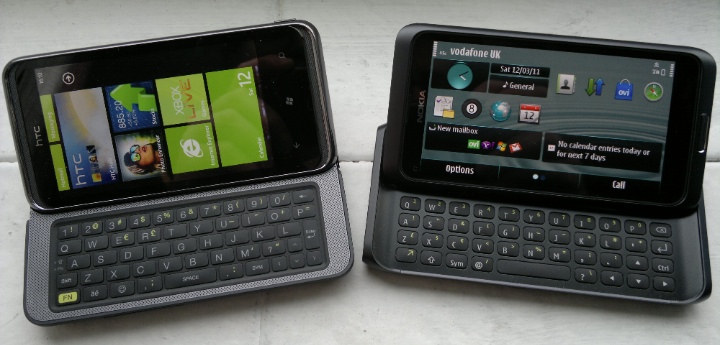
In theory, the Nokia E7 and HTC 7 Pro are aimed at exactly the same market. People who do a lot of business telephony, email and texting, plus Office document handling, with a handful of games to while away plane and train trips - and a smattering of media capture and media consumption on the site. In short, the typical 'Communicator' demographic.
Making the two devices perfect for a direct comparison, now that I've tried each in the real world. The principle attributes are great QWERTY keyboard, tilted up screen ('laptop' mode, shown above) and a business-focussed software suite.
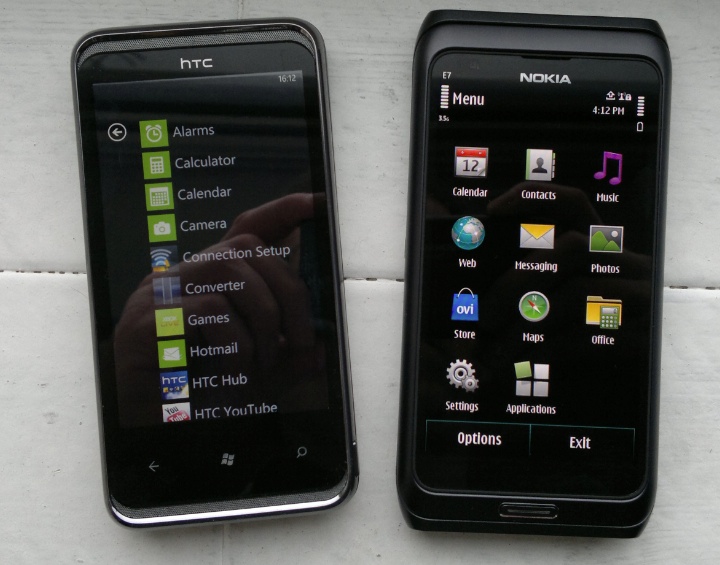 As you can see from the photos, the Nokia E7 is slightly larger, in plan view, but thinner. The HTC 7 Pro is smaller and squatter. Also notable in the photo above is the far better contrast in Nokia's CBD display compared to the 'old' transmissive LCD display on the HTC. I'll return to screen contrast again below...
As you can see from the photos, the Nokia E7 is slightly larger, in plan view, but thinner. The HTC 7 Pro is smaller and squatter. Also notable in the photo above is the far better contrast in Nokia's CBD display compared to the 'old' transmissive LCD display on the HTC. I'll return to screen contrast again below...
As with previous head to heads, where appropriate/possible (in some rows it's simply too subjective or there isn't a clear leader), I've shaded in a 'winner' in green for each attribute, to give a visual guide to possible superiority. Did I mention the word "slaughter" in the opening paragraph? Ahem. Prepare yourself for a left-hand column that's mainly green...
| Nokia E7 | HTC 7 Pro | |
| Form factor and input method, build quality | Aluminium shell with pivoting display on sturdy metal hinge. Lovely hardware, lovely form factor, incredible build quality, very thin for the keyboard size | Traditional QWERTY slider with hinged and sprung slide-ends, so that the screen pops up at an angle once extended. The mechanism is wobbly and unsatisfying. The side to side wobble in the slide action is actually so bad that it's easy to 'wedge' the screen half way up the keyboard, held in place against its own spring action by virtue of being angled to one side or the other. Tilted up, the 7 Pro's form factor is pleasing - it's how you get there that irritates - every time you use it. |
| Display | 4" CBD AMOLED, pretty good in sunlight, 640 pixels by 360. Made of Gorilla Glass and almost impossible to scratch. | 3.6" 'Super LCD', 800 pixels by 480, washes out in sunlight and disappointing compared to AMOLED screens in almost all conditions. |
| Display flexibility | 99.5% of OS and application screens work in both portrait and landscape modes | Many (over 50%) of OS and application screens only work in portrait mode, landscape is just for selected apps and scenarios/dialogs, with keyboard extended |
| Keyboard | Four row keyboard, nominal key travel but excellent feel, punctuation via long key presses or Fn/Sym keys | Five row keyboard, key travel isn't quite as much as the E7's and the space bar only has one microswitch underneath, so you have to hit it dead centre. It's a minor thing, but enough to make the keyboard a disappointment overall. |
| Weight | 176g (notable win because of being lighter despite the build quality, the larger screen and keyboard) | 185g |
| Operating system and interface | Symbian^3, firmware updates just beginning (hopefully). OS is mature, the interface is quirky but well known, raw functionality and flexibility is class-leading. | Windows Phone 7, updates (very) slowly arriving but estimated (by me) to currently be a year or two behind other mobile OS in terms of overall functionality. The interface is slick and potentially superior to most other operating systems - but it's currently a triumph of eye candy over ability, certainly for power users. |
| Free RAM, free user memory, expansion for apps and media | Over 140MB free RAM, over 330MB free on system disk, 16GB mass memory, no expansion. The absence of microSD expansion not only limits capacity, it also takes away a means of transferring media between devices. Partly to compensate for this, a USB on the go system (via supplied adapter) means that USB sticks/disks can be connected. On any desktop system, the E7's mass memory mounts via USB and can be used as any other disk for file transfer and media transfer. | Either 8GB or 16GB of mass memory. No expansion, as on the E7. Media has to be side-loaded (in both directions, i.e. for saving captured photos and videos) via the Zune suite for Windows or a 'Mac Connector' (in beta). |
| Processor, chipset notes, peformance | ARM11, 680 MHz, plus Broadcom BCM2727 graphics acceleration, pretty quick for most (though not all) operations, full and responsive multitasking. Let down by the speed of several central applications (Email being the biggest culprit) | 1GHz Scorpion processor, very quick and responsive interface for built-in apps. Many installed applications severely impeded in terms of performance by lack of third party app multitasking, i.e. everything has to start from scratch over and over again. |
| Camera | 8 megapixels EDoF (i.e. full focus, no macro), dual LED flash. Disappointing for business use in practice. Almost everything I'd want to capture in an office, for example, requires a degree of auto-focus. Casual snaps outdoors come out well though. | Usual HTC 5 megapixels auto-focus unit, LED flash. Photos appear with excessive edge enhancement and indoor photos are disappointing, as you'd expect. Autofocus works well for macro subjects, document photography etc. Overall, I'd have to settle for this in a Communicator than the E7's EDoF unit, though the margin in small and neither camera can produce results even slightly comparable to those from the Nokia N8, for example. |
| Camcorder | Decent 720p video with excellent digital sound | Acceptable 720p video and quietish audio capture. Interface crippled by Windows Phone habit of reverting everything to defaults if you so much as switch to a different app for five seconds. Thus, most people's videos will end up in VGA resolution. Gah! |
| Application load-out highlights (out of the box) | Ovi Maps with free navigation, Ovi Store, Quickoffice editing suite, Photo and Video editors | Xbox Live integration, Windows Phone Marketplace, Bing Maps, Pocket Office, YouTube HD client (a HTC addition) |
| Web browsing/working on the Internet | Web as per the N97 and E90, with Flash built-in and now with multitouch support. Interface is dated and multi-stage page rendering now clumsy with 2011's bloated, multi Megabyte web pages | Internet Explorer. Better than Nokia's browser, slower than Android's or iPhone's. No Flash support and an appallingly minimalist interface, but intelligent paragraph zooming and general responsiveness wins out overall. |
| Messaging, Email | Nokia Email (nee Messaging) works pretty well, albeit a bit slow. Many people find bypassing Nokia's servers (by declining the terms of service) improves things a lot, using IMAP directly. Either way, the experience is powerful but never quick. Can't believe I'm awarding a win to Nokia Messaging - it's an AAS first, I think. It's just that competition is so weak. | Basic email client, good Microsoft Exchange/Live integration but very limited in terms of overall functionality (e.g. can only attach photos and videos to email - if you want to attach a [shock, horror] Office document then you have to send it explicitly, one by one, from within the relevant Office application) |
| Audio out | 3.5mm, plus tinny mono speaker | 3.5mm, plus even tinnier and scratchier mono speaker |
| Battery capacity, life | 1200mAh, fixed with no user access at all, recharge each night, microUSB charging. | 1500mAh replaceable, recharge each night, microUSB charging. Worth noting that the battery cover is fiddly to open and replace and has to be done with the keyboard mechanism extended. |
| Connectivity notes | Quad-band GSM, Pentaband 3G, Bluetooth, Wi-Fi, GPS | Quad-band GSM, dual band 3G, Bluetooth, Wi-fi, GPS |
| Video apps and capabilities | Symbian^3 video player, very slick, looks great on the big CBD display. Handles H.263/H.264/AVC MP4, plus DivX, WMV and many other formats and variants. HDMI out to compatible equipment | Adequate video playback for most MP4 and WMV variants |
| Application ecosystem | Plentiful software, including HD GPU-aware games, arguably weak area is cloud service integration apps | Growing software scene, a nice mix of games and cloud service integration apps, but all horribly crippled by the lack of multitasking, with its performance implications (e.g. not wanting to wait 10 seconds for Twitter to start up, over and over again) |
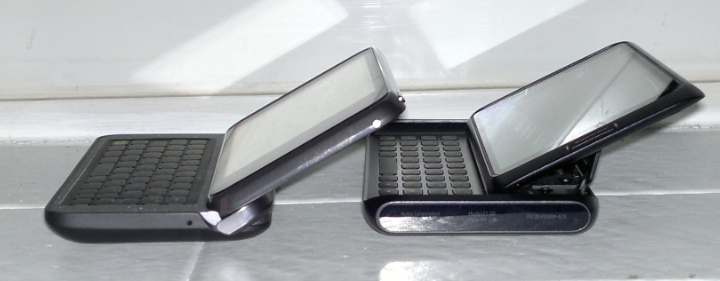
Showing the tilt angles and mechanisms of the two devices. The 7 Pro is far less stable, physically, in that the slightest touch on the screen is enough to set the device toppling back, whereas you have to press quite hard to achieve the same on the E7. Also of note is that opening the HTC 7 Pro's mechanism is almost as tricky as opening the E7's, amazingly. You have (as on the E7) to work out just the right place to brace your index fingers at the back and, as with the E7, there's a definite risk of dropping the device during the opening process.
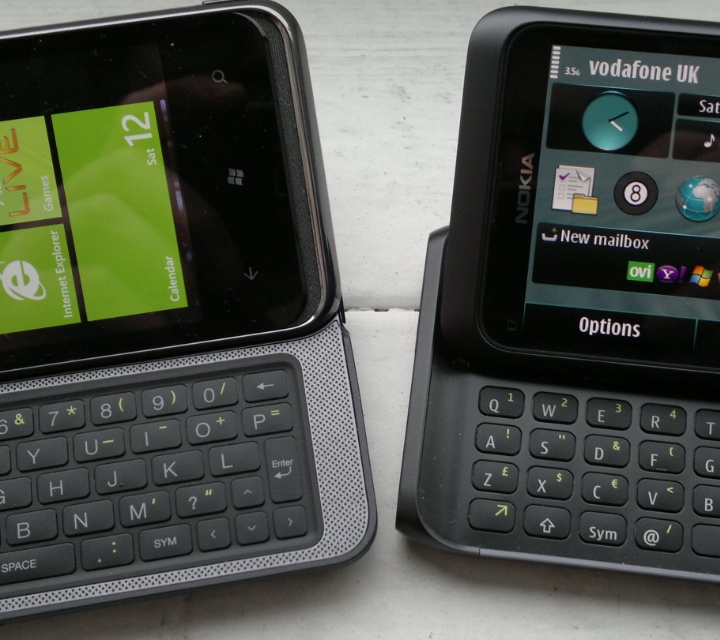 A close-up of the first photo. Note the different interpretations of the QWERTY layout, which will tickle different personal preferences. There's not much between the keyboards - the 7 Pro has more keys but uses them less efficiently (there's even one for inserting 'smileys'!) and its space bar is very poorly implemented.
A close-up of the first photo. Note the different interpretations of the QWERTY layout, which will tickle different personal preferences. There's not much between the keyboards - the 7 Pro has more keys but uses them less efficiently (there's even one for inserting 'smileys'!) and its space bar is very poorly implemented.
In contrast, the E7 has better overall key feel and uses the excellent 'longpress to insert function character' system, and comes out on top overall.
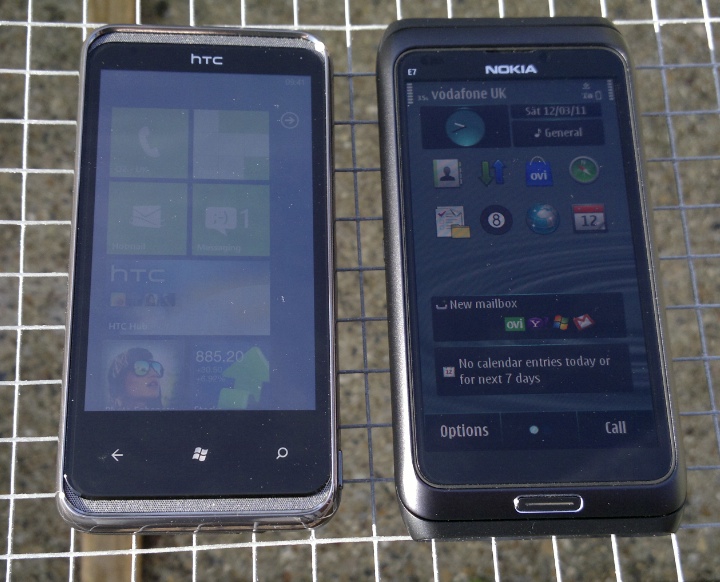 Regular readers will know that I've championed the use of display technologies which can actually be read outdoors when the sun comes out, and the industry has largely listened to me (and others). The HTC 7 Pro uses 'Super LCD' and seems to be backlit (i.e. TFT), which means that there's no transflective layer to use ambient light to its advantage.
Regular readers will know that I've championed the use of display technologies which can actually be read outdoors when the sun comes out, and the industry has largely listened to me (and others). The HTC 7 Pro uses 'Super LCD' and seems to be backlit (i.e. TFT), which means that there's no transflective layer to use ambient light to its advantage.
In contrast, the E7's AMOLED display should be just as disadvantaged by competing with the sun, but the extra polarising layers in the glass mean that reflections are almost completely irradicated and you see the AMOLED blacks as black and colours with far more recognition.
_____________________
What makes this comparison particularly apt is that the HTC 7 Pro is using an operating system and interface that Nokia is going to use from 2012 onwards (and abandoning active Symbian development in the process). You'll gather from my comments above that there are still many 'holes' in Windows Phone 7 and I can only hope that Nokia's engineers have a lengthy 'shopping list' of fixes and enhancements that they're hitting Microsoft with. As it stands Windows Phone 7 has the eye candy but Symbian OS has the functionality and maturity. Will another 9 months of development be enough for Microsoft to catch up to Symbian and Android in these regards?
Aside from software notes, you'll also gather from the table above that Nokia's hardware is streets ahead of HTC's. The latter has a reputation for building 'solid' handsets - Nokia has a reputation for making ones that are virtually indestructible. Maybe the partnership of Nokia hardware and Microsoft software will produce something special next year? Or maybe Symbian will have advanced far enough in 2011 that the E7 and its descendants will continue to raise the bar for the next generation of Nokia devices based on Redmond's OS?
In the meantime, if you were having doubts about buying the E7, don't even think about the HTC 7 Pro as an alternative - it's just not in the same class.
Steve Litchfield, All About Symbian, 13 Mar 2011
